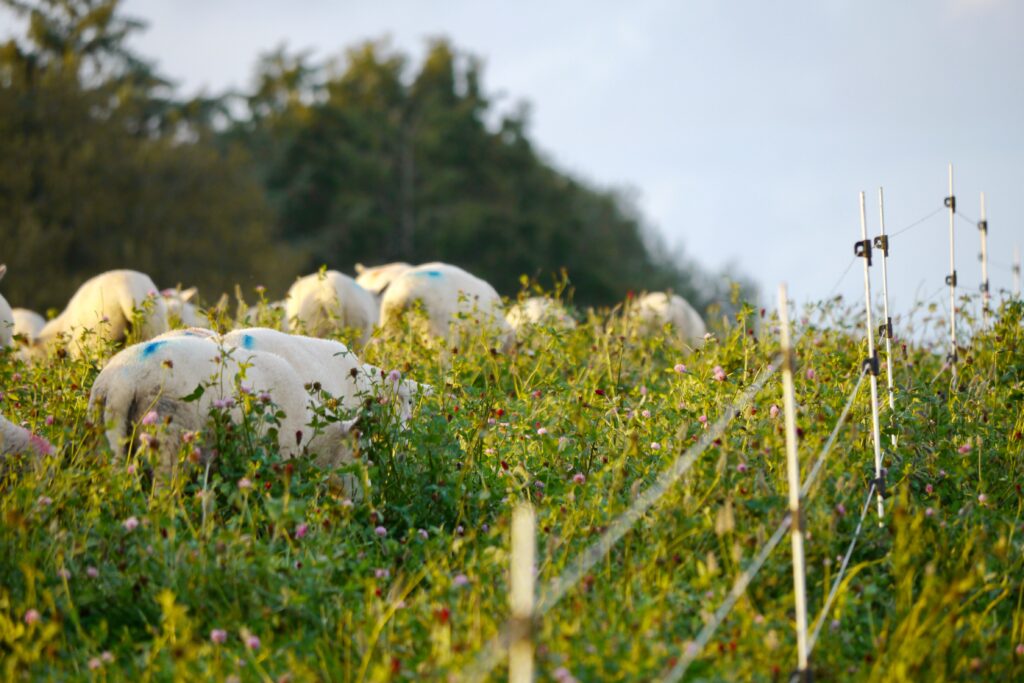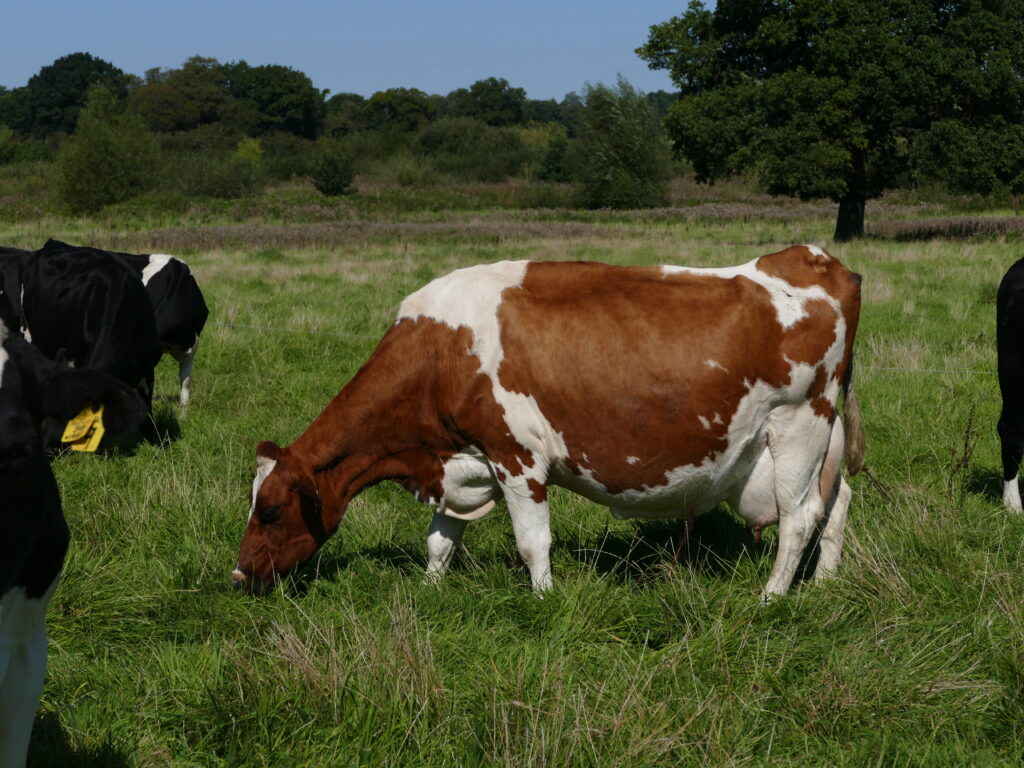Re-thinking efficiency and the future role of ruminants
By Pasture for Life Research Officer Sara Hall
 (Photo: by Olly Walker, PfL certified Essebeare Farm, Devon)
(Photo: by Olly Walker, PfL certified Essebeare Farm, Devon)
While there is no doubt that food systems and the agricultural sector need to operate within “planetary boundaries”, meeting these urgent obligations for carbon neutrality and restored biodiversity, alongside global food security, are looking increasingly difficult unless society accepts a fundamental change to “business as usual”.
In the UK, the agricultural sector is responsible for 10% of our greenhouse gas emissions (GHG) and of that 54% is thought to be caused by methane, a shorter lived but more potent GHG than carbon dioxide (Agri-climate report 2021). The mitigation of ruminant enteric methane therefore offers a promising low-hanging target for global emission reduction. Strategies of intensification and specifically increased production efficiency of ruminant livestock is currently deemed a national priority for methane emission reduction, with the simple premise that the more a ruminant animal can produce in meat or milk in the shortest amount of time, the less methane emissions per kg or product there will be. This increased production efficiency, alongside static global consumption of the product would in turn allow an overall reduction in ruminant populations and offer a tantalising suggestion of “freed up” land for reforestation. However, while production efficiency is mathematically logical, it is also clear that this direction of travel will require a continued and considerable cereal input into ruminant diets, potentially leading to a reduction in ecologically important permanent grasslands.
It is also important to note that while all our current conversations relating to emissions in agriculture are most often based around GHG emissions per kg of food the value of food is of course not by weight, but nutritional value and the benefit to human health. We should in the future be looking to discuss the footprint of foods based on their nutritional benefit alone (McNicol et al, 2024, McAuliffe GA et al, 2020).
An alternative approach to assess efficiency
Scientists at the University of Nottingham considered the term efficiency within the UK livestock sector with particular focus on the constant drive for intensification of systems that inevitably leads to animals and humans competing for the same high energy crops such as cereals. (Wilkinson, 2011). The paper highlighted that edible protein input per unit of fresh animal protein output i.e. the feed conversion ratio (FCR) should ideally be such that livestock systems produce more edible energy and or protein than is consumed as feed i.e. an FCR of 1.0 or lower. They modelled that this was potentially possible through replacement of human edible cereal and soybean in feed concentrates with cereal/plant by-products and high-quality grass forage.
The authors were further able to demonstrate that if the lens of efficiency is adjusted; “by accounting for the proportion of human-edible and inedible feeds used in typical livestock production systems, a more realistic estimate of efficiency can be used for purposes of comparison….” They demonstrated that under these conditions it is evident that the most efficient systems are grass based dairy and upland suckler beef systems where the ruminant’s ability to convert forage un-available to humans into the human edible proteins of milk and meat makes them a more resource efficient livestock animal than their monogastric peers.
(Photo: by Olly Walker at PfL certified Essebeare Farm, Devon)
The role of ruminants and permanent grasslands in the future
If pasture based ruminant systems can be considered more efficient in terms of optimised land use and reduced competition for human edible cereals, then it is clear that the grassland they graze will need to become an essential part of the future agricultural landscape.
Poux and Albert (2022) have offered a very different logic to agricultural intensification in their recently published paper: Putting permanent grassland at the heart of a European agroecological transition: Findings and questions arising from the ‘Ten Years for Agroecology’ (TYFA) scenario. They argue for a complete change in European agricultural policy having created a model built around permanent grassland, which demonstrates that under certain conditions:
“ an agroecological Europe could sustainably and healthily feed 530 million.
European citizens by 2050 while restoring biodiversity and reducing GHG emissions”.
The model makes a number of key assumptions, including;
- reintroduction of livestock into all crop systems
- a reintroduction of grassland to 10% of current cropland
- no soybean/plant protein imports
- legume introduction to all crop rotations
- a phasing out of pesticides
- a 45% calorie reduction in the human diet of animals that can eat grain alone eg pigs and poultry
- a 31% reduction in dairy by 2050 alongside moderate reductions in suckler livestock through extensification.
The authors go further to incorporate a 50% reduction in cereal production but a four-fold increase in protein crops within the human diet (both made possible from the reduced requirements within the dairy and monogastric sector). It is proposed by the authors that if these radical changes were made there would be a 36% reduction in greenhouse gas emissions (GHG.) They also highlight the protection and reintroduction of permanent grasslands (PG) as a cornerstone to efficient nitrogen transfer and the source of 70% of the feed needed by ruminants.
Scarcity Management over yield maximisation
While the production of food has always been considered the goal of agriculture, it is becoming clear that the remit of farmers needs to expand beyond food productivity and high yield prioritisation, to the wider stewardship of the land– improving the efficiency of the resources available to benefit the environment, biodiversity, and society.
A French policy briefing, Biomass, and climate neutrality in 2050: managing scarcity to maintain productive and resilient ecosystems, released by the Institut du developement durable et des relations internationales ( IDDRI) (Aubert, n.d.) delivered key messages around the increased demands for food, energy, materials, carbon storage and biodiversity. They noted that the Nega-watt-Afterres, WWFs 2050 Biomass and the French National Low Carbon Strategy scenarios all envisaged a doubling of non-food biomass requirements and so the pressure on land use for the food and energy sector is set to increase.
The solution suggested by the author includes a large number of changes within the agricultural sector including the reduction of artificial fertilisers and the re-introduction of circular systems within agriculture. However they also highlighted the urgent and essential need for a scarcity management approach; where the concept of trade-off is accepted and complex decisions around a reduction in our own consumption are made at government policy level.
 (Photo: by Angus Birditt at PfL certified Hill Farm Real Food, Cheshire)
(Photo: by Angus Birditt at PfL certified Hill Farm Real Food, Cheshire)
An alternative vision
It is clearly evident in the last 80 years that the production of food has been central to much of Europe’s farming policy and that an increase in production efficiency in both the livestock and arable sector has been central to the growth in intensification.
However when our lens on efficiency is broadened, and we consider not only how efficient animals are in production but also how efficiently we use natural resources for all, and minimise damage to them, it builds a strong case for the protection of soil and grasslands, agroecological practices and a clear perspective on our current reliance on using human edible crops in livestock production.
The challenge, as we have now discovered in the climate crisis, is that identifying the changes needed from society is the first step but the costs to individuals in making those changes needs to be clearly communicated. It is highly likely that a fundamental change in agricultural policy, away from intensification, would have difficult implications and that a social licence to change our consumption rates would be essential for success.
References
Aubert, P.-M. (n.d.). Biomass and climate neutrality in 2050: managing scarcity to maintain productive and resilient ecosystems. https://www.flux-biomasse.fr/resultats/sankey_matieres_premieres/
McNicol LC, Perkins LS, Gibbons J,Scollan ND, Nugent AP, Thomas EM,Swancott EL, McRoberts C, White A,Chambers S, Farmer L and Williams AP (2024)The nutritional value of meat shouldbe considered when comparing the carbon footprint of lambs produced on differentfinishing diets.Front. Sustain. Food Syst. 8:1321288.doi: 10.3389/fsufs.2024.1321288
McAuliffe GA, Takahashi T, Lee MRF. Applications of nutritional functional units in commodity-level life cycle assessment (LCA) of agri-food systems. Int J Life Cycle Assess. 2020;25(2):208-221. doi: 10.1007/s11367-019-01679-7. Epub 2019 Sep 7. PMID: 32063684; PMCID: PMC6994510.
Poux, X., & Aubert, P. M. (2022). Putting permanent grassland at the heart of a European agroecological transition: Findings and questions arising from the ‘Ten Years for Agroecology’ (TYFA) scenario. Grass and Forage Science, 77(4), 257–269. https://doi.org/10.1111/gfs.12597
Wilkinson, J. M. (2011). Re-defining efficiency of feed use by livestock. Animal, 5(7), 1014–1022. https://doi.org/10.1017/S175173111100005X
Official statistics: Agri-climate report 2021, Oct 2021, https://www.gov.uk/government/statistics/agri-climate-report-2021/agri-climate-report-2021#section-5-what-you-need-to-know-about-this-release



